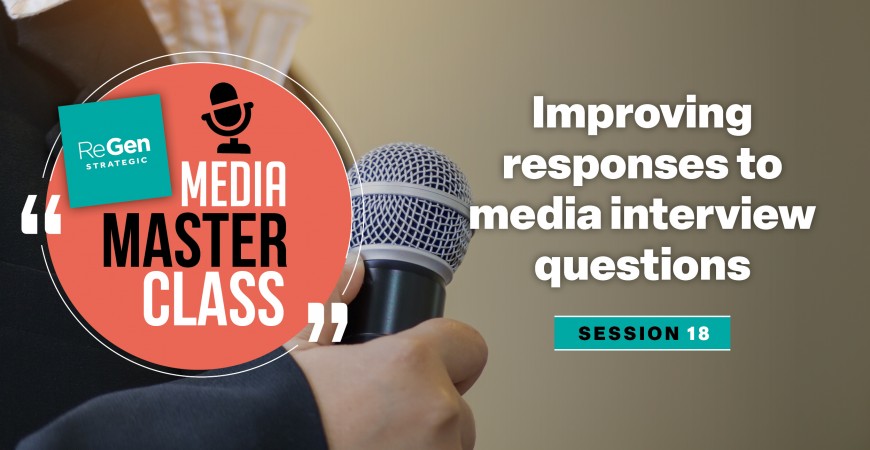In an earlier session of Media Masterclass, we talked about how to avoid interview traps, but knowing the different types of questions and how to respond to them in a way that gets your key messages across is an art form in and of itself.
Imagine you’re getting ready for a media interview or press conference and you’ve prepared your key messages for the topic you want to talk about, but the media only want to ask you about an unrelated issue.
It’s something that happens to politicians all the time – they might be opening a new school, but the journalists only want to ask about an accusation made by a rival MP.
Other times, a journalist might only ask a yes or no question, leaving you with seemingly no way to answer the question with any degree of nuance.
Rather than accept these situations passively and leave the press conference with your carefully crafted key messages unsaid, there are techniques available to help achieve the result you want for your organisation – and we’re going to share them with you.
The most important to master is bridging, which is when you move from a topic you don’t want to talk about to one you do – delivered through your key messages. When bridging from one topic to another, it’s important to acknowledge and address the original question before moving on to what you’d like to talk about. For example, you might answer, “Yes, that is the view of some in the community, but in addition to that I’d say [key message]”, or, “I don’t know that that’s necessarily the case, but what I can tell you is [key message]”, or, “Well, while that is a challenge, I think what’s important to focus on is [key message]”.
Re-framing the conversation, or putting things into a different context, can also be an effective way of bridging, particularly as journalists have a habit of focusing on the negative. For example, “Well, statistically that may be the case, but let me put that figure into perspective for you…” or “Well if you look at it in isolation, that could be perceived as a challenge, but put in the broader context, it’s a very different picture because…”
While these techniques can be applied in almost any situation, there are some types of questions that require a specific response.
Hypothetical questions are when an interviewer is trying to draw you into speculating with your answer. Many interviewees have been caught out when what they’ve speculated about doesn’t eventuate. To avoid this, you might respond with, “I can’t speculate any better than the next person about hypotheticals, but let me tell you what actually happened the last time...”.
Other times, an interviewer might try putting words in your mouth by asking a loaded question like “would you agree that…?”. If you agree with their statement, their language can get attributed to you. If a journalist tries to put negative language or words you don’t like in this sort of question, it’s possible to answer without repeating them. For example, you might say, “Well I wouldn’t necessarily put it like that. Let me put it this way…”.
If you’re asked a direct question which states a fact, it’s important to give a direct answer or you might appear to be hiding something, but you should still employ bridging afterwards to make your point. For example, if you are asked, “Doesn’t Western Australia only account for a small share of direct global emissions?”, you could respond with, “That may be the case, but there’s more to understanding our impact on the climate than direct emissions. What we’re saying is…”.
Sometimes journalists ask questions you didn’t anticipate, and you might need to stall for time. To do so without appearing flustered, pause for a moment before answering, then comment on or repeat the question while you formulate your response. For example, you might begin by saying, “That’s an interesting question. I’m glad you asked that because there are a lot of misperceptions about…”, or, “Let me make sure I understand what you’re asking… [repeat question]”.
Even if you’re a subject-matter expert, there are going to be questions outside your realm of knowledge every so often. Don’t be afraid to admit this and be honest about not knowing the answer – do not be drawn into speculating or guessing. It is much harder to correct the record later if you realise you’ve given inaccurate information. If it’s something you can look up and report back on, like a particular figure, simply state that you don’t have the information to hand and will have to check and get back to them. Then, try bridging from the topic you don’t know about to one that you do, once again taking the opportunity to deliver your key messages. For example, “That’s not a figure I currently have at hand, however what I can tell you is (key message)”.
Finally, an interviewer will sometimes ask questions you don’t want to answer, but instead of saying, “no comment”, you should acknowledge the question, then bridge to your preferred topic. For example, “That’s a complex question; however, what I believe we need to focus on is [key message]”.
If you found these techniques useful, we recommend reading our earlier session about avoiding interview traps that journalists set for unsuspecting interviewees. While these guides are helpful, there’s no better preparation for media interviews than practising in realistic conditions with former journalists.
Contact us today to learn more about our bespoke media training to get the results you want from media.
 ReGen Strategic
ReGen Strategic